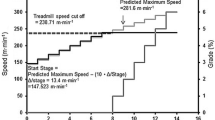Summary
A maximal predictive cycle ergometer (CE) test for estimating maximal oxygen uptake (\(\dot V\)O2 max) was evaluated in 15 male and 12 female subjects. The test consisted of pedalling a cycle ergometer (Monark) at 75 rev·min−1, beginning at an intensity of 37.5 watts and increasing by this amount each min until the subject could no longer maintain pedal rate. The highest work rate achieved was recorded as the endpoint of the test and used to construct regression equations to predict \(\dot V\)O2 max. This was compared with two direct measures of \(\dot V\)O2 max [an interrupted treadmill (TM) run and an interrupted CE procedure at 60 rev·min−1] and with the submaximal predictive test of åstrand-Rhyming. When compared to TM \(\dot V\)O2 max, \(\dot V\)O2 measured during the final 30 s of the maximal predictive CE test was 16.0% and 16.2% lower for males and females respectively; compared to \(\dot V\)O2 max determined by the direct CE test, it was lower by 2.9% for males and 5.2% for females. Correlation coefficients for \(\dot V\)O2 max predicted from the maximal predictive CE test and \(\dot V\)O2 max measured directly by CE and TM were 0.89 and 0.87 for males and 0.88 and 0.83 for females (p<0.01), respectively. The \(\dot V\)O2 max predicted from the åstrand-Rhyming test correlated significantly with \(\dot V\)O2 max max measured by CE and TM only in the male group. Test-retest reliability coefficients for intensity (watts) on the maximal predictive CE test were 0.95 and 0.81 for males and females respectively (p<0.01). The data suggest that this CE test gives a reliable and valid estimate of \(\dot V\)O2 max.
Similar content being viewed by others
References
åstrand P-O, Rodahl K (1977) Evaluation of physical work capacity on the basis of tests. In: Textbook of work physiology. McGraw-Hill, New York, pp 331–365
åstrand P-O, Rhyming I (1954) A nomogram for calculation of aerobic capacity (physical fitness) from pulse rate during submaximal work. J Appl Physiol 7: 218–221
Cooper KH (1968) A means of assessing maximal oxygen intake. JAMA 203: 201–204
Davies CTM (1968) Limitations to the prediction of maximum oxygen intake from cardiac frequency measurements. J Appl Physiol 24: 700–706
DeVries HA, Klafs CE (1965) Prediction of maximal oxygen uptake from submaximal tests. J Sports Med 5: 207–214
Faulkner JA, Roberts DE, Elk RL, Conway J (1971) Cardiovascular responses to submaximum and maximum effort cycling and running. J Appl Physiol 30: 457–461
Glassford RG, Baycraft GHY, Sedgwick AW, MacNab RBJ (1965) Comparison of maximal oxygen uptake values determined by predicted and actual methods. J Appl Physiol 20: 509–514
Harrison MH, Bruce DL, Brown GA, Cochrane LA (1980) A comparison of some indirect methods of predicting maximal oxygen uptake. Aviat Space Environ Med 51: 1128–1133
Hermansen L, Saltin B (1969) Oxygen uptake during treadmill and bicycle exercise. J Appl Physiol 26: 31–37
Issekutz B, Birkhead NC, Rodahl K (1962) Use of respiratory quotients in assessment of aerobic capacity. J Appl Physiol 17: 47–50
Kamon E, Pandolf KB (1972) Maximal aerobic power during laddermill climbing, uphill running, and cycling. J Appl Physiol 32: 467–473
Keren G, Magazanik A, Epstein Y (1980) A comparison of various methods for the determination of \(\dot V\)O2 max. Eur J Appl Physiol 45: 117–124
Margaria R, Aghemo P, Rovelli E (1965) Indirect determination of maximal oxygen consumption in man. J Appl Physiol 20: 1070–1073
McArdle WD, Katch KI, Pechar GS (1973) Comparison of continuous and discontinuous treadmill and bicycle tests for max 140-2. Med Sci Sports 5: 156–160
Mitchell JH, Sproule BJ, Chapman CB (1957) The physiological meaning of the maximal oxygen uptake test. J Clin Invest 37: 538–547
Patton JF, Vogel JA, Kowal DM (1978) Requirements for fitness according to job assignment in the US Army. Proc NATO Symp on Physical Fitness, Toronto, Canada, pp 87–92
Rowell LB, Taylor HL, Wang Y (1964) Limitations to prediction of maximal oxygen intake. J Appl Physiol 19: 919–927
Shepard RJ, Allen C, Banade AJS, Davies CTM, diPrampero PE, Hedman R, Merriman JE, Myhre K, Simmins RS (1968) The maximum oxygen intake. An international reference standard of cardiorespiratory fitness. Bull WHO 38: 757–765
Taylor HL, Buskirk E, Henschel A (1955) Maximal oxygen uptake a an objective measurement of cardiorespiratory performance. J Appl Physiol 8: 73–80
Verma SS, Gupta JS, Malhotra MS (1977) Prediction of maximal aerobic power in man. Eur J Appl Physiol 36: 215–222
Vogel JA, Wright JE, Patton JF, Sharp DS, Dawson J, Eschenback MP (1980) A system for establishing occupationally-related gender-free physical fitness standards. US Army Research Institute of Environmental Medicine Technical Report, No T5/80
Wells CL, Scrutton WE, Archibald LD, Cooke WP, DeLaMothe JW (1973) Physical working capacity and maximal oxygen uptake of teenaged athletes. Med Sci Sports 5: 232–238
Woynarowska B (1980) The validity of indirect estimations of maximal oxygen uptake in children 11–12 years of age. Eur J Appl Physiol 43: 19–23
Wyndham CH (1967) Submaximal tests for estimating maximum oxygen uptake. Can Med Assoc J 96: 736–742
Author information
Authors and Affiliations
Rights and permissions
About this article
Cite this article
Patton, J.F., Vogel, J.A. & Mello, R.P. Evaluation of a maximal predictive cycle ergometer test of aerobic power. Europ. J. Appl. Physiol. 49, 131–140 (1982). https://doi.org/10.1007/BF00428971
Accepted:
Issue Date:
DOI: https://doi.org/10.1007/BF00428971




